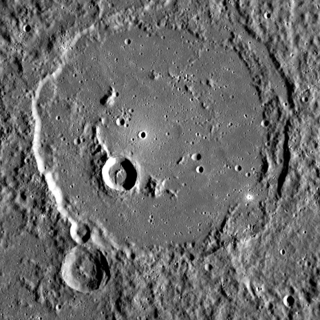
Michelangelo is a 230 km diameter impact basin in the Michelangelo quadrangle of Mercury, which is named after this crater. The crater itself was named by the IAU in 1979 after the Italian painter, sculptor and architect Michelangelo.

Vivaldi is a crater on Mercury. It was named by the IAU after Italian composer Antonio Vivaldi in 1976. It has a prominent and nearly continuous inner ring whose diameter measures about half that of the outer ring. It is one of 110 peak ring basins on Mercury. Unlike some of the lunar multiringed structures, no vestiges of additional rings are apparent around this crater. It is classified as c3 age.

Mozart is a crater on Mercury, named by the IAU in 1976 after Austrian composer Wolfgang Amadeus Mozart.

Polygnotus is a crater on Mercury, named by the IAU in 1976, after ancient Greek painter Polygnotus. The crater was first imaged by Mariner 10 in 1974.

Praxiteles is a crater on Mercury. It is one of 110 peak ring basins on Mercury.

Moody is an impact crater on Mercury.

Raditladi is a large impact crater on Mercury with a diameter of 263 km. Inside its peak ring there is a system of concentric extensional troughs (graben), which are rare surface features on Mercury. The floor of Raditladi is partially covered by relatively light smooth plains, which are thought to be a product of the effusive volcanism. The troughs may also have resulted from volcanic processes under the floor of Raditladi. The basin is relatively young, probably younger than one billion years, with only a few small impact craters on its floor and with well-preserved basin walls and peak-ring structure. It is one of 110 peak ring basins on Mercury.

Munkácsy, named after Mihály Munkácsy, is a crater on Mercury. Munkácsy originally had a double-ring basin structure, but most of the inner ring was buried when the basin was flooded with volcanic lava. Only a few remnants of the ring poke up through the lava, although low ridges in the lava seem to trace out much of the rest of the ring's circumference. Munkácsy is one of 110 peak ring basins on Mercury.

Scarlatti is a pit-floored crater on Mercury, which was discovered in 1974 by the Mariner 10 spacecraft. It has a prominent peak ring, and it is one of 110 peak ring basins on Mercury. The crater floor is covered by the smooth plains material. The crater displays an arcuate collapse feature along the northeastern peak ring. The size of the pit, which was first noticed in MESSENGER images obtained in January 2008, is 38 × 12 km. Such a feature may have resulted from collapse of a magma chamber underlying the central peak ring complex of the crater. The collapse feature is an analog of Earth's volcanic calderas. Scarlatti is thought to have the same age as the Caloris basin.

Hokusai is a rayed impact crater on Mercury, which was discovered in 1991 by ground-based radar observations conducted at Goldstone Observatory. The crater was initially known as feature B. Its appearance was so dissimilar to other impact craters that it was once thought to be a shield volcano. However, improved radar images by the Arecibo Observatory obtained later in 2000–2005 clearly showed that feature B is an impact crater with an extensive ray system. The bright appearance of rays in the radio images indicates that the crater is geologically young; fresh impact ejecta has a rough surface, which leads to strong scattering of radio waves.

Ahmad Baba is a crater on Mercury. It has a diameter of 127 kilometers. Its name was adopted by the International Astronomical Union (IAU) in 1979.

Aksakov is a crater on Mercury. It has a diameter of 174 kilometers. Its name was adopted by the International Astronomical Union (IAU) on April 24, 2012. Aksakov is named for the Russian author Sergey Aksakov, who lived from 1791 to 1859 C.E.

Cervantes is a crater on Mercury. It has a diameter of 181 kilometers. Its name was adopted by the International Astronomical Union in 1976. Cervantes is named for the Spanish writer Miguel de Cervantes, who lived from 1547 to 1616.

Chekhov is a crater on Mercury. It has a diameter of 194 kilometers. Its name was adopted by the International Astronomical Union (IAU) in 1976. Chekhov is named for the Russian author Anton Chekhov, who lived from 1860 to 1904.

Dürer is a crater on Mercury. It has a diameter of 195 kilometers. Its name was adopted by the International Astronomical Union (IAU) in 1976. Durer is named for the German artist Albrecht Dürer, who lived from 1471 to 1528.

Machaut is a crater on Mercury. Its name was adopted by the International Astronomical Union in 1976. Machaut is named for the French composer and poet Guillaume de Machaut, who lived from 1300 to 1377. The crater was first imaged by Mariner 10 in 1974.

Mark Twain is a crater on Mercury. Its name was adopted by the International Astronomical Union (IAU) in 1976. Mark Twain is named for the American author Mark Twain, who lived from 1835 to 1910.

Holst is a crater on Mercury. Its name was adopted by the International Astronomical Union (IAU) on April 24, 2012.

Alver is a crater on Mercury. It has a diameter of 151.49 kilometers. Its name was adopted by the International Astronomical Union (IAU) on March 15, 2013. Alver is named for the Estonian poet Betti Alver.

Faulkner is a crater on Mercury. It has a diameter of 168 kilometres. Its name was adopted by the International Astronomical Union (IAU) on April 24, 2012. Faulkner is named for the American author William Faulkner.





















